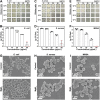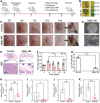Reactive Microneedle Patches with Antibacterial and Dead Bacteria-Trapping Abilities for Skin Infection Treatment
- PMID: 38582511
- PMCID: PMC11186059
- DOI: 10.1002/advs.202309622
Reactive Microneedle Patches with Antibacterial and Dead Bacteria-Trapping Abilities for Skin Infection Treatment
Abstract
Bacterial skin infections are highly prevalent and pose a significant public health threat. Current strategies are primarily focused on the inhibition of bacterial activation while disregarding the excessive inflammation induced by dead bacteria remaining in the body and the effect of the acidic microenvironment during therapy. In this study, a novel dual-functional MgB2 microparticles integrated microneedle (MgB2 MN) patch is presented to kill bacteria and eliminate dead bacteria for skin infection management. The MgB2 microparticles not only can produce a local alkaline microenvironment to promote the proliferation and migration of fibroblasts and keratinocytes, but also achieve >5 log bacterial inactivation. Besides, the MgB2 microparticles effectively mitigate dead bacteria-induced inflammation through interaction with lipopolysaccharide (LPS). With the incorporation of these MgB2 microparticles, the resultant MgB2 MN patches effectively kill bacteria and capture dead bacteria, thereby mitigating these bacteria-induced inflammation. Therefore, the MgB2 MN patches show good therapeutic efficacy in managing animal bacterial skin infections, including abscesses and wounds. These results indicate that reactive metal borides-integrated microneedle patches hold great promise for the treatment of clinical skin infections.
Keywords: eliminate dead bacteria; microenvironment; microneedle; reactive metal boride; skin infection.
© 2024 The Authors. Advanced Science published by Wiley‐VCH GmbH.
Conflict of interest statement
The authors declare no conflict of interest.
Figures








References
-
- Raff A. B., Kroshinsky D., J. Am. Med. Assoc. 2016, 316, 325.
-
- Choi V., Rohn J. L., Stoodley P., Carugo D., Stride E., Nat. Rev. Microbiol. 2023, 21, 555. - PubMed
MeSH terms
Substances
Grants and funding
- 82102335/National Natural Science Foundation of China
- 52073060/National Natural Science Foundation of China
- 2020YFA0908200/National Key Research and Development Program of China
- 2021B1515120054/Guangdong Basic and Applied Basic Research Foundation
- JCYJ20190813152616459/Shenzhen Fundamental Research Program
LinkOut - more resources
Full Text Sources
Medical
Miscellaneous
